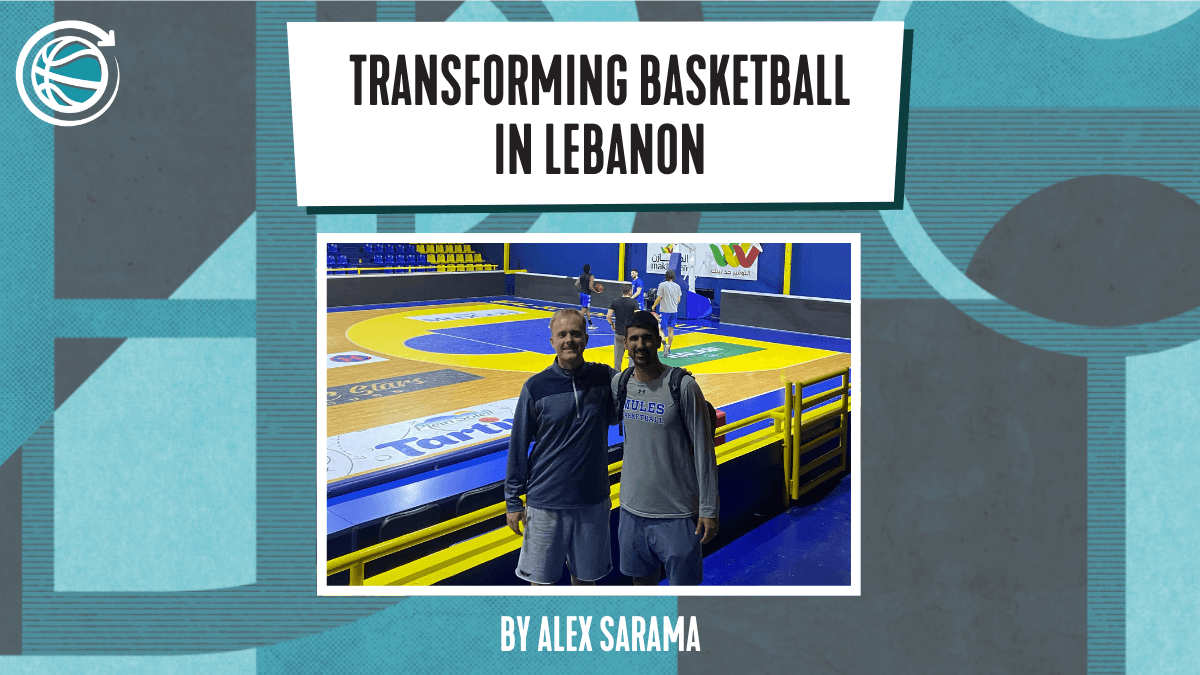An Introduction: Evidence-Based Ideas in Basketball


Approaches within the basketball industry are predominantly based upon experiential knowledge and traditions. This is perhaps most notable within coaching. Every year, advancements in several fields of human life render previous approaches obsolete. Despite this, the basketball world has largely remained immune to such developments. Attitudes and coaching approaches in 2024 remain not too indifferent from how the game was coached several decades ago.
As such, the adoption of evidence-based ideas have much to offer the basketball world. Many individuals working in a variety of roles across basketball are not yet aware that there is a whole field dedicated to understanding how athletes develop skills more effectively than traditional methods. Skill acquisition research informs us that there is an alternative to participating in drills, teaching fundamentals, repeating ‘moves’ and using highly patterned offenses.
While the need to underpin coaching approaches with an evidence-based framework is often met with ambivalence, the introduction of such ideas is the next frontier to breach within basketball. Curious individuals and open-minded organisations therefore stand with the most to gain! This is where Transforming fits in…
Transforming Basketball exists to help coaches, front office staff, athletic performance coaches, physios, nutritionists and any other basketball practitioner, understand and practically apply these ideas. Many of these ideas are based upon contemporary skill acquisition research. Used interchangeably with motor learning, skill acquisition is simply an evidence-based field studying how athletes become more skilful.
Reframing Basketball Performance
This approach is a radically new way to make sense of performance in basketball and the role of the coach. In order to make sense of what this approach looks like, it’s necessary to understand the rationale behind it. Over the years, coaches and other practitioners have not received opportunities to learn about human movement. A highly simplistic view of player development and developing ‘skills’ has led to a focus on techniques and players practicing in environments featuring minimal variability or decision-making.
A contemporary approach starts with asking the question of “how does movement actually occur, leading to the skills observed during the course of a game?” By understanding and reframing human movement, it leads to a realisation that many current processes in basketball can be substantially improved. Comprehending human movement leads to a realisation that variability is a crucial part of practice, rather than something that should be avoided through highly scripted and repetitive practice drills.
Ecological dynamics is a framework which can be used to understand human movement, specifically related to the processes of action, perception and cognition. This extends to everything we do as human beings, extending to how players move within their practice or game environments.1 The relationship between the environment and individual underpins the ecological approach.
Information in the environment shapes every movement that emerges within basketball, yet so frequently, key information from this environment is removed in player development and team practice settings. A player dribbles in the game with the intent to solve a problem by evading, advancing or deceiving a defender. Static dribbling and two ball dribbling tasks are therefore not relevant within an ecological approach because they share no connection to the task of dribbling within the game itself.
The roots of ecological dynamics (ED) originate from two fields: ecological psychology and dynamical systems theory. An understanding of both is therefore required to appreciate how they inherently complement each other. Understanding ecological dynamics allows coaches to move beyond traditional paradigms.
The Basics of Ecological Dynamics
Across the upcoming weeks, months and years, Transforming Basketball exists to help organisations, coaches and other basketball practitioners make sense of an ecological approach. In this blog, a highly condensed version is provided to introduce these ideas, as well as to highlight just how much there is to be explored. Understanding ecological dynamics starts with unpacking its two contributing fields:
Dynamical Systems Theory 101:
A foundational element of Dynamical Systems Theory (DST) is the premise that humans – and therefore basketball players – are complex, adaptive systems. This means that players and entire teams behave in nonlinear and unpredictable ways. Recognising that basketball teams and players are complex systems means that individual movements observed in sequences such as passing, finishing and shooting, as well as in team-wide movements such as executing an offensive pattern, all emerge as a result of self-organisation.
Self-organisation accounts for the movements that are observed during every moment of a possession. Movements emerge without the brain processing and controlling the entire movement. This means there is no such thing as perceive-decide-execute or ‘muscle memory’. Players simply do not have time to decide and then retrieve a desired movement action. If a player shoots a lay-up, the various components of the human body (bones, joints, muscles, ligaments etc) self-organise to produce the movements required for that action.
If players do not have time to pre-plan, recall or retrieve their movements, then as coaches, why do we so frequently allow them to practice in such a predictable fashion? As written by Myszka et al., “an athlete rarely has the luxury of identifying, or deliberating on, a list of alternative options to employ in trying to solve a problem.” 2
Furthermore if players all self-organise in different ways as a result of their unique anatomy, why as coaches do we attempt to solve the problem for the players by providing them with the techniques that they should use? Self-organisation implies that instead, as coaches we should consider creating environments that allow players to problem-solve by self-organising in different ways. This naturally leads to appreciating the importance of variability and moving away from a ‘one-size’ fits all approach. There is no ‘one way’ to perform a skill because what is functional for one player could be very different for another. Skill acquisition research overwhelmingly indicates that when players receive internal feedback based on how they should be controlling their body, it is suboptimal for performance. 3
Ecological Psychology 101:
First coined by the ecological psychologist JJ Gibson, an ‘affordance’ is an opportunity or invitation for action. Affordances are specific to every player, and they appear and disappear rapidly during every possession. Picture a player quickly cutting to the basket or sprinting beyond the 3PT line after a ghost screen: they may only be open for a fraction of a second, before the affordance landscape changes. For instance, if the defense recovers, instead of passing to the open teammate, other affordances may appear such as opportunities to drive or get open again through running another trigger, etc.
The ability of a player to perform successfully in the game is predicated around consistently acting upon the most advantageous and attractive affordances. In doing so, players must select an affordance from many possible options, before self-organising successfully in order to act on the desired affordance. This is the notion of ‘perception-action’ coupling. Both processes are inextricably linked: movements in every basketball action only occur after the perception of an affordance. Why would players ever move in the game if not perceiving some type of invitation for action?
The key reflection becomes one of how well traditional practice drills prepare players to become skilful. In practice environments all over the world and at all levels of basketball, the most frequented basketball drills contain few authentic affordance landscapes. Additionally, such environments rarely provide opportunities for functional self-organisation to occur because of how so many movements are predetermined by the coach. Rather than players having the opportunity to problem-solve and move in authentic ways, problems are effectively solved for the players by the coaches. This means that in many instances, player development is left up to chance or mere luck.
Drills such as the three man weave, shell drill, 3-on-0, 1-on-0 moves repetition, form shooting and any form of static dribbling are incompatible with the basic science of human movement. An ecological dynamics framework not only changes how we view performance within the game itself, but also how we approach coaching and every other role.
The Constraints-Led Approach
While ecological dynamics provides a theoretical framework to make sense of performance in basketball, it does not provide a specific ‘how to’ for coaches to practically implement an ecological approach in their practices. This is where the constraints-led approach enters the equation.
The constraints-led approach (CLA) is informed by ecological dynamics. This means to adopt a CLA effectively, an understanding of ecological dynamics and the theory behind it is essential. An introduction to the CLA is summarised below for coaches being introduced to this for the first time:
- An effective usage of the CLA features coaches using a wide variety of small-sided games in several different formats, e.g. 1-on-1, 1-on-1+1, 1-on-2, 2-on-1, 2-on-2, 3-on-2, 3-on-3, 3-on-3+1 etc. This serves as an alternative to using drills.
- Coaches create environments for movements (aka skills) to emerge, rather than explicitly instructing players and teaching them what to do. This requires creative thinking.
Coaches manipulate constraints (more on this later) to create varied affordances. - This is NOT a games approach. A games-based approach (e.g. just playing small-sided games) is different to the CLA, and not that much more beneficial using drills. Check out EP22 of the Transforming Podcast (listed below) for more on this.
- Coaches adopt an exploratory tone, moving away from automatic rules and mental models which stipulate what skills should supposedly look like.
- Coaches are not overtly instructive. While instruction can be used, coaches instead focus on changing the environment by manipulating constraints to make some affordances appear more enticing.
- Using principles of play (e.g. conceptual offense) rather than game models and overtly rigid motion offenses/ set plays. Principles of play should frequently be embedded into CLA activities.
Manipulating Constraints
If coaches merely set up small sided games and instruct, this is a games approach. This is commonly too vague and generic for effective development to occur. Within a CLA, coaches manipulate constraints for a highly specific reason rather than running small-sided games for the sake of it. Reasons to manipulate constraints may include:
- Manipulating constraints to develop principles of play (e.g. how to convert advantages when in “dominoes” or punishing a switch in pick and roll)
- Manipulating constraints to nudge players towards affordances they are not aware of (these could be highly specific such as the opportunity to reject in a pick and roll, or rotate back to neutral if the offense have an advantage).
- Manipulating constraints to improve the deficiencies of individual players in particular areas, e.g. a player struggling to finish adaptively or dribble against pressure. In ecological terms, these are known as rate limiters.
An awareness of these factors should inform the intentions of every coach. Without a clear intent, a CLA cannot be used well. In order to understand how to manipulate constraints, it is necessary to understand what constraints are.
According to Karl Newell, there are three categories of constraint: individual, task and environment. 4 It is best to view constraints as interacting variables which impact self-organisation. Despite what their name suggests, constraints are not merely restrictive or oppressive elements! Below is an example of how constraints could be manipulated within practice. Due to their nature, task constraints are the constraint category which can be most readily manipulated by coaches.
| Task Constraints | Environmental Constraints | Individual Constraints |
| The rules of the game | Playing music or crowd sounds | Playing against different teammates to lead to varied movements emerging |
| Starting locations, number of players and area to play in within a small-sided game | Different equipment (e.g. rim height and ball sizes) | Playing with different teammates to lead to varied movements emerging |
| The scoring systems (e.g. double points for a rim finish, scoring only after a paint touch etc). | Different court surfaces | Using an athletic performance program |
| The time available (e.g. playing with a shorter or changing shot clock) | Lighting and temperature | Introducing a mindfulness program to help players cope with anxiety/ confidence, etc. |
| Introducing mindfulness | Culture of the team | Fatigue levels |
See what the CLA looks like in-action in this full-length practice:
Practical Applications:
To get a better idea of how constraints can be manipulated, check out these quick video links to get a deeper understanding of the CLA in-action:
For warm-ups vs traditional dynamic stretching and movement routines: https://twitter.com/AlexJSarama/status/1449031706028171271?s=20
For ball handling vs traditional static dribbling or any type of dribbling drill without an opponent:
https://twitter.com/AlexJSarama/status/1612558407549984768?s=20
For finishing vs 1-on-0 moves rehearsal: https://twitter.com/AlexJSarama/status/1464628029095878658?s=20
For shooting vs form shooting and spot shooting: https://twitter.com/AlexJSarama/status/1537129772353921024?s=20
For offensive principles of play vs 3-on-0 and 5-on-0: https://twitter.com/AlexJSarama/status/1546589024265113603?s=20
Why Does This Matter?
“If successful performance requires adaptability to changes in personal, task and/or environmental characteristics, why would we not practice in performance environments that challenge individuals to deal with dynamic individual, task and environmental constraints that emerge in competitive contexts?” 5 – Renshaw et al., 2022
The implications for using a CLA are obvious: coaches and organisations now have an opportunity to develop players in a manner which aligns with the research rather than relying on an ‘always done it this way’ approach. This offers a unique opportunity to move beyond tradition for the betterment of the players.
This methodology is difficult to dispute because of how it accounts for movement in every form of life. Therefore even in the most traditional practice environments, the CLA accounts for how movements emerge through the process of interacting constraints and perception-action coupling. The key difference therefore lies in what coaches use the CLA intentionally by understanding the theory behind it to develop skilful players.
Learning is highly nonlinear. The myth that a player must be explicitly taught something before being able to do it conflicts with basic human logic. While research can be highlighted to prove this, it is simply obvious when observing the complexity of movements in a game that even youth players move in ways that have never been taught. If this was the case, basketball would be an extremely dull sport to watch.
Despite this, in 2023 coaches still believe in fundamentals, drills, teaching moves and highly restrictive offenses. Furthermore, many coaches believe that the CLA can only be done after players first develop the ‘basics.’ The fact that the majority of attitudes within the basketball world remain stuck in the past is not anyone’s fault: I was in the same position five years ago. In the present day however, it’s up to as a global community of coaches and practitioners to accept that players deserve better. Therefore, it’s on us to educate ourselves and move on from how things have always been done. You can begin this process of change through the five action steps listed below.
Action Steps
Here are six action-steps from the ideas shared within this blog:
- (Re)consider what skills are. Skills are not actions or techniques. In its simplest form, they are the relationship between the player and their environment. In the words of Professor Rob Gray, “Skill is the ability of a player to use information from the environment to find and execute a movement solution.” 6
- Enhance, rather than reduce, variability within the practice environment.
- Explore creative ways to add a defender to all practice activities.
- To avoid adopting an overtly passive games-based approach, consider how you can manipulate constraints frequently during the practice.
- Consider how you can “design in” affordances to practice activities, promoting opportunities for functional self-organisation to occur.
- Attempt to abandon entrenched preconceived notions within the basketball world. This includes the fact there is no ‘correct’ way to perform a skill, in addition to the belief that practices should look neat and tidy. If they are, the practice is likely not conducive for any form of effective learning to occur.
Questions?
The aim of this article is to provide you with an opportunity for refection. You may be asking questions such as:
- How can this be used with beginners?
- How can the CLA with professional players?
- How can an ecological approach be applied to shooting?
- How could tactical concepts be developed through constant manipulations?
- How could these ideas be applied to every part of an organisation, including fields such as athletic performance, physio, performance analysis and more?
Helping you answer such questions is why Transforming Basketball exists! Through our blogs, podcasts, social media, in-person events, and online courses, workshops and clinics, our mission is to quite literally transform the basketball world. Engage with our content and shoot us an email via info@transformingbasketball.com if we can help you navigate this exciting new journey!
1 Seifert, L., & Davids, K. (2017). Ecological Dynamics: A Theoretical Framework for Understanding Sport Performance, Physical Education and Physical Activity. First Complex Systems Digital Campus World E-Conference.
2 Myszka, S., Yearby, T., & Davids, K. (2023). (Re)conceptualizing movement behavior 2in sport as a problem-solving activity. Frontiers in sports and active living, 5, 1130131
3 Wulf, G. (2007). Attention and motor skill learning. Champaign, IL: Human Kinetics
4 Newell, K. M. (1986). Constraints on the Development of Coordination. In M. G. Wade, & H. T. A. 4Whiting (Eds.), Motor Development in Children: Aspects of Coordination and Control (pp. 341-360). The Netherlands: Martinus Nijhoff, Dordrecht.
5 Renshaw, I., & Davids, K., & O’Sullivan, M., & Maloney, M., & Crowther, R., & Mccosker, C. 5(2022). An ecological dynamics approach to motor learning in practice: Reframing the learning and performing relationship in high performance sport. Asian Journal of Sport and Exercise Psychology. 2. 10.1016
6 Gray, R. (2022). Action Capacity vs Skill: Training to Expand the Field of Affordances. https://youtu.be/RXT5UKKSWzs























